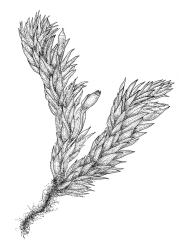- ≡ Bellia Broth., Nat. Pflanzenfam. [Engler & Prantl] 1(3), 923 (1907) nom. illeg.
The following generic description is modified from Vitt (1977).
Plants medium-sized for the family, usually yellow-green above and darker below, lustrous, forming tufts or mats, usually epiphytic and often on small branches. Stems prostrate or ascendant, dark brown, soft or wiry, beset below with smooth rhizoids, in cross-section with or without a central strand. Leaves not differentiated into ranks, loosely imbricate to flexuose-erect when dry, erect-spreading or secund when moist, not or weakly complanate, lanceolate to oblong-lanceolate, acuminate or cuspidate, bordered by several rows of linear cells; upper laminal cells firm-walled, smooth, rounded-hexagonal to rounded-rhomboid or elongate rhombic, gradually becoming ± linear towards insertion; basal laminal cells larger, ± oblong-hexagonal or linear-rhomboid, firm- or thin-walled, weakly or not porose; marginal cells linear and thick-walled, forming a border 3–8 cells wide at mid leaf; alar cells not differentiated. Costa strong, single, unbranched, percurrent or excurrent and fusing with the border at apex. Propagulae sometimes present in axillary clusters, fusiform, and septate.
Dioicous. Setae ± flexuose, rather short, red-brown, smooth throughout or scabrous above; capsules inclined, oblong-cylindric from a tapered and tuberculate neck; exothecial cells isodiametric or subquadrate, strongly collenchymatous, arranged in well-defined longitudinal ranks; stomata restricted to neck, superficial; annulus apparently absent (not seen); operculum long-rostrate from a conic base. Peristome double, inserted at mouth; exostome teeth yellow-brown, linear-lanceolate, narrowly furrowed, cross-striate below, ± baculate near apex, with high ventral lamellae that project laterally as stout marginal trabeculae; endostome pale yellow, from ¾ to nearly equal the exostome in length, with a short or high basal membrane, segments biseriate or uniseriate, with or without narrow perforations; cilia absent. Calyptra mitrate, laciniate-fringed at base, enclosing the entire capsule. Spores round or reniform, mostly 20–40 µm, papillose.
Crosbya is an endemic N.Z. genus consisting of two species. Vitt (1977) proposed the generic name Crosbya and discussed the history and taxonomy of the genus and its component taxa.
The relationship between Crosbya and Daltonia remains inadequately understood. Both of the species placed in Crosbya by Vitt (1977) have well-developed endostomal basal membranes, while Daltonia (typified by D. splachnoides (Sm.) Hook. & Taylor) lacks an endostomal membrane. However, numerous gametophytic and sporophytic features differentiate C. nervosa and C. straminea and suggest a closer relationship between C. nervosa and Daltonia splachnoides. Gametophytic similarities between these latter two taxa include leaf insertion, orientation, shape, and areolation, stem anatomy (both have a central strand), and habit. Additionally, the setae of C. nervosa are often weakly scabrous above, as are those of many species of Daltonia. Neither a stem central strand nor scabrous setae occur in Crosbya straminea. If more detailed study justifies the transfer of C. nervosa to Daltonia (the combination Daltonia nervosa was published by Müller (1850–1851, p. 17)), the generic name Crosbya Vitt will become a synonym of Daltonia Hook. & Taylor. It is thus unfortunate that Vitt (1977) selected C. nervosa rather than C. straminea as the type species of Crosbya. A typification using C. straminea (Daltonia straminea Beckett) would have precluded potential nomenclatural confusion. Further investigation of this problem, perhaps using molecular methods, is warranted but beyond the scope of this Flora.
Crosbya is retained in the Daltoniaceae on the authority of Goffinet et al. (2009). According to Buck (pers. comm., 26 Jan. 2008) the peristome differences between genera of Daltoniaceae "seem to mirror habitat choices rather than phylogeny" and he believes that molecular data "strongly hold [the Daltoniaceae] together".
| 1 | Stems short, mostly <7 mm, with a central strand; leaves erect-spreading when moist, lanceolate, cuspidate-acuminate and asymmetric at apices, mostly 1.3–1.9 mm long; upper laminal cells ± hexagonal, mostly 9–12 µm long; endostomal segments biseriate and narrowly perforate; propagulae not seen and presumably absent; restricted to Auckland and Campbell Is | C. nervosa |
| 1' | Stems longer, commonly 20–30 mm, lacking a central strand; leaves secund when moist; leaves oblong-lanceolate, narrowly acute to acuminate and symmetric at apices, mostly 2.0–2.3 mm long; upper laminal cells rounded-rhomboid, mostly 15–24 µm long; endostomal segments uniseriate and not perforate; propagulae frequent in leaf axils, fusiform, and mostly 5-celled; widespread on North, South, and Stewart Is | C. straminea |
| Category | Number |
|---|---|
| Indigenous (Endemic) | 2 |
| Total | 2 |




